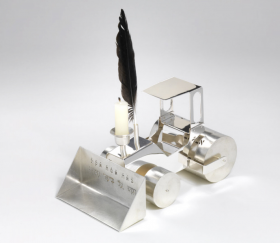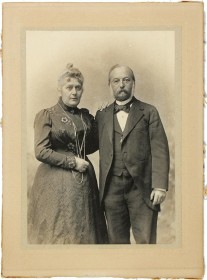Passover in Jerusalem

This miniature steamroller by the artist Avi Biran is put to work in the ritual search for leavened grain. If chametz is found in the house, it can literally make it flat as a pancake, Jerusalem 2008; Jewish Museum Berlin, photo: Jens Ziehe. You can find this and other objects related in our German-language collection database.
The time before Passover always seems a bit chaotic to me. Jerusalem looks a little like a German city just before Christmas. Everyone has off work and is busy preparing for the holiday: there is a lot to buy for the seder evening, and many people buy new clothing to look sharp for the family dinner. In homes and buildings across the city, rags, brooms, and vacuums flail frantically. This spring cleaning has a religious motivation: → continue reading

Shlomit Tulgan made this Seder plate from clay for our children’s exhibition on Passover; Jewish Museum Berlin, photo: Jens Ziehe.
It’s Seder and the family is getting together. Some are traveling from farther away, others are flourishing right here. At the table are escarole, lettuce, parsley, kohlrabi, Belgian endive, and dandelion. But what about horseradish and red radish? They’re both late this year.
The story of the plants and their fruits that have particular meaning on the Seder plate at Passover could be told in various similar ways. They all grow in the Diaspora Garden, which you can visit inside the W. Michael Blumenthal Academy at the Jewish Museum. → continue reading

Emanuel and Johanna Stern, ca. 1903; Jewish Museum Berlin, gift of Alexander Summerville
Just over two years ago, I penned a blog text describing a Passover Haggada that I had purchased online. It caught my attention due to the lists of names written on the inside front and back covers of individuals who attended the Passover Seders over the course of seven years that were held in two residences in Berlin, both of which were in close proximity to the Jewish Museum Berlin. Research revealed a substantial amount of information about various persons named therein and my text concluded with the hope that contact might be established with descendants of some of those found in the lists.
At the end of March of this year, I flew to Stockholm to visit Alexander Summerville, the great grandson of Paul Aron, in whose home in the Hedemannstraße 13/14 Passover Seders took place in five of the years for which lists exist in the Haggada. → continue reading


